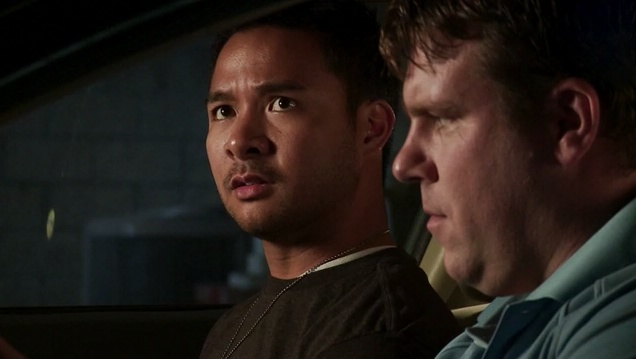About a week and a half ago, my friend Ron Adair told me about an ad contest Doritos was having for the Super Bowl. I had never heard of it and wasn’t aware that it was done last year as well. He told me that he was entering the contest and to take a look at his submission for feedback. I was a bit saddened that I hadn’t heard about it yet, being that the deadline was four days away! I told my wife, Wendy, about it and she said we should do it. She came up with an idea that day and we shot it the following night. We wrangled two of our friends (who were not actors) to act and then edited it well into that same night. Wendy wrote and directed it and I shot and edited it.
Here is the spot for reference:
We shot it in two and a half hours in our drive way with just my wife, the two actors (J.J. Calica and Scott Weed) and myself as a one-man lighting/grip/camera crew. I used my Sony EX1 without any lens adapters with one wireless lav mic, gaff-taped to the dashboard of the car the talent was sitting in. I had a four-piece Arri lighting kit that I “borrowed” from my director friend, Greg Whiteley (it’s stored in my garage). I wish I had taken a photo of the lighting setups to post here, but to no avail.
For the frontal two-shot of the actors and the frontal medium closeup of the driver, I used the Arri 1K with a medium Chimera softbox for the key, placed camera left just off of the frame line and almost right up onto the car. It was probably two feet from the windshield. I didn’t have any grip equipment or louvres for the softbox to control the light spilling onto the hood of the car, so I had to darken that part of the hood in Final Cut Pro. I had one 650W fresnel unit on the passenger side of the car—cross lighting the driver through the rear passenger-side window, no diffusion. I had another 650W fresnel on the opposite side of the car—cross lighting the passenger through the rear driver-side window with a sheet of 216 diffusion and a sheet of the tissue paper that single sheets of diffusion/gels are sold with for added softness (because I had nothing else to use). Lastly, I had the remaining unit—a 300W fresnel—on a stand about eight feet up pointing down into the back seats through the back window to illuminate the backseat and give the shot some sort of background. It had some full CTB on it—not a choice I would’ve normally made; but again, it was all I had. I wish I had been able to light up the street behind the car, but you can only do so much with four lights.
I set the color temperature of the camera to 41ooK to make both the tungsten and “daylight” light look warmer. I wanted the lighting to be warmer anyway and I especially didn’t want full-blue “moonlight,” so why put 1/4 CTO on all the lights when I can do it electronically in the camera—besides, I didn’t have 1/4 CTO on hand anyway!
For the coverage shots, I basically mirrored the following setup: The 1K softbox key, still through the windshield, favoring slightly to the camera side of the car just to get the light a little more on the shadow side of the face. For fill light, I used blue painter’s tape (didn’t have camera or paper tape) to attach some of that tissue paper from the gels onto the rear side window and pointed the 650W fresnel through it. Then I used the other 650W fresnel with the double diffusion through the rear window behind the actor for a soft edge light. The 300W in the backseat stayed on, even though it wasn’t seen in the frame. For the driver’s background (a concrete-block wall), I didn’t have to do anything; it had just enough light on it from the key light to register and not be too bright. For the passenger’s background, I had more to work with and there was about ten times more depth than the driver’s side. All I did was use that 300W with the CTB and spotted it down (and carefully positioned it) on the far wall to help define some of the objects in the background—but just enough to have something back there.
I didn’t measure any lights or use any zebra stripes to set exposure but I did glance at the histogram from time to time. In order to get the least amount of depth-of-field, I started off with no lighting, used the longer end of the lens and opened the camera’s iris wide open and lit by eye from there. The EX1, although it has a larger chip than other cameras in its class, still has more depth of field than I would want, but it’s what I got. It seemed to work out pretty well as I didn’t have to do any color or exposure correction in post, with the exception of the shots through the windshield to remove the green tint that all car windows tend to give (oh, and that pesky key light spill on the dash).
That’s about all we did. For what it is, I think it turned out all right! Not sure how well Doritos is going to go for the subject matter, but it’s a shot. Maybe they’ll go edgy this year.


